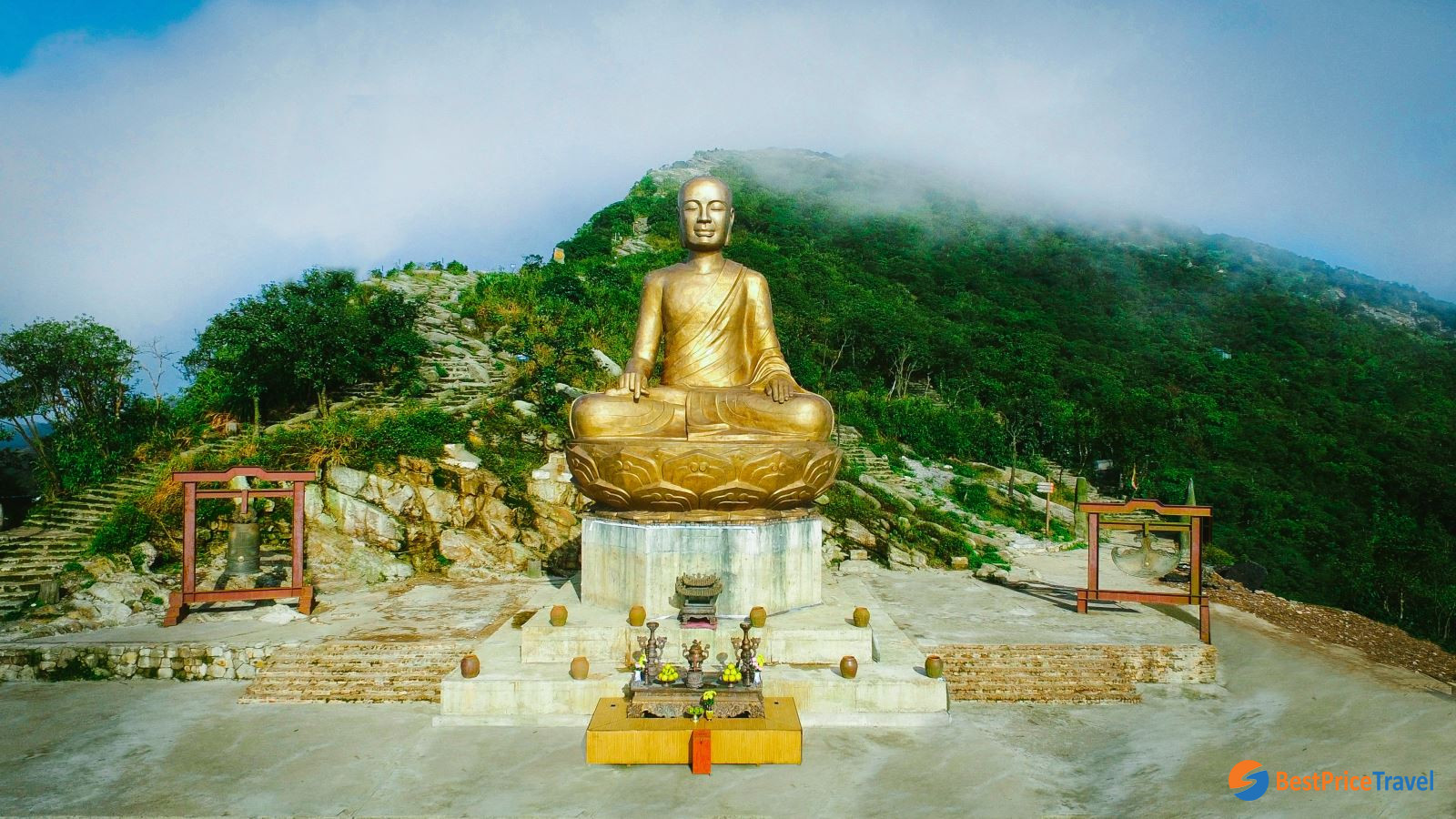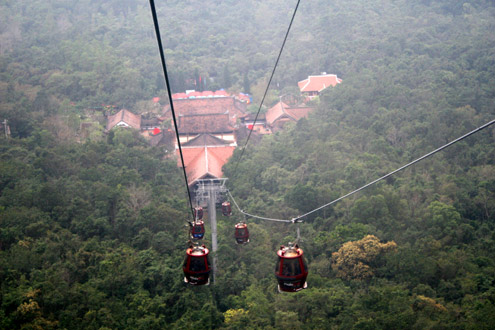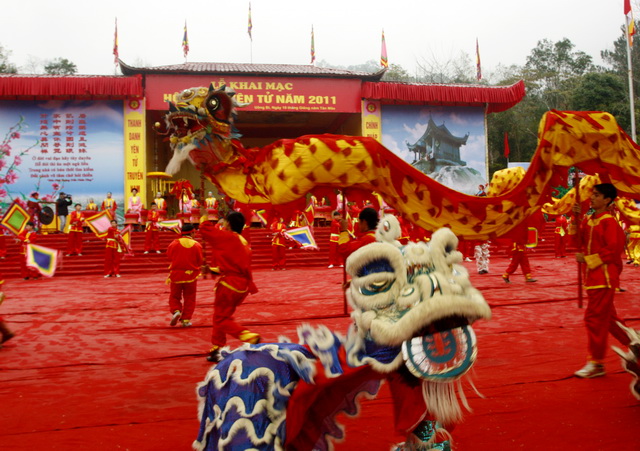Yen Tu Mountain
Buddhism has been existed in Vietnam for more than 2.000 years. Yen Tu pagoda has long been associated with the name of Buddhist king Tran Nhan Tong who founded the Truc Lam Zen. This pagoda is the capital of Buddhism of Dai Viet (the old name of Vietnam). With the unique location, architecture and history, Yen Tu pagoda has been recognized as a special relic of Vietnam.
History
More than 700 years ago, after two victorious defends against the mighty Mongolian army (1285 and 12870), King Tran Nhan Tong left the royal palace in Thang Long (Hanoi nowadays) to found Truc Lam Zen sect with a unique Buddhist culture of the Vietnamese people.

Buddhist King Tran Nhan Tong
He went to Yen Tu mountain to build Yen Tu Pagoda and to lead an ascetic religious life on a day in 1299. Later, people called him the “Buddhist King”. Visitors from all over the country will go to Yen Tu pagoda from the 10th of January according to the lunar calendar to attend the Yen Tu festival, worship Buddha, and view the spectacular scenery.
Culture
Yen Tu has been the center of Buddhism in Vietnam for many centuries. Every year on February 28th (January 10th in the Lunar calendar), the opening ceremony of the Yen Tu festival took place in Giai Oan yard, Yen Tu mountain, Uong Bi City, Quang Ninh province. Yen Tu festival is one out of several spring festival in Vietnam and it last for 3 spring months. During that 3 months, millions of visitors will come to Yen Tu pagoda to join the festival, worship to Buddha, King Tran Nhan Tong, pray for luck, health and wealth for the new year.
Yen Tu festival on the opening day
On the opening day, Yen Tu festival will welcome the attendance of Quang Ninh province’s president and many other leaders. The ceremony will start with a speech then chairman of Quang Ninh province and the chairman of Quang Ninh Buddhism will hit the drum, and ring the gigantic golden bell to officially start the festival. Even if you are not Buddhist, you can still enjoy the religious atmosphere of the Yen Tu festival as well as the Vietnamese new year.
When to travel
Weather
Located thousands of meters below the ocean level, Yen Tu pagoda has its own unique weather all year round. The weather here is cool all year round, cold in the winter, often 10 degrees lower compare to the ground. If you decide to go to Yen Tu in the spring to attend the Yen Tu festival, chances are you will be faced thick fog which can cause rain. All north of Vietnam rains in the first few months of the lunar new year, that’s the fact.
The best ideal time to travel
It is appropriate to visit Yen Tu at any time of the year due to its mild and pleasant temperature. However, there is a three-month festival in the mountain from January to March, so many Buddhists make the pilgrimage to this revered site for prayer from all over the nation. The devotees view it as a chance to express to Buddha their sincere wishes for a happy new year as well as to escape their sorrows and misery from the previous year. Therefore, if you intend to worship at Yen Tu, now is the greatest time for you to take in the spectacular mountain view and participate in the massive Buddhist celebration, especially in February when it is less crowded.
If you plan to visit the mountain for sightseeing, it is best to do so between September and December when fewer tourists are present, allowing you to enjoy the tranquil, serene atmosphere and making it easier for you to climb to the grand mountain peak.
Where to visit
- Truc Lam Yen Tu
A pagoda on Yen Tu Mountain is called Truc Lam Yen Tu. It is also referred to as Lan Pagoda or Long Dong Tu. King Tran Nhan Tong constructed and embellished this pagoda in 1293 so that he could deliver sermons to other monks. On a hill that resembles a dragon lying down, you can find Lan Pagoda. The historical remnants of Lan Pagoda are still present. A nearly 4-ton bronze statue of Buddha can be found in the pagoda's courtyard. A statue of Bo De Diem made of wood that stands 3.2 meters tall, weighs roughly 3.2 tons, and has intricate carvings is located behind the Main Hall.
- Giai Oan Stream
The following place you go is Giai Oan Stream. According to legend, hundreds of royal concubines committed suicide by drowning in the mountain stream after failing to convince the King to return to the palace. The king, therefore, constructed the Giai Oan Pagoda next to the stream to provide a home for the lost souls and serve as a reminder to others of them.
- Hue Quang Tower
Visitors will reach Hue Quang Tower Garden if they continue climbing up 500m higher from the stream and then stroll along a path through lush pine trees. A tower with a statue of Buddhist King Tran Nhan Tong inside can be found here. The marble monument is 62 cm tall and is encircled by 97 other, smaller stupas of Yen Tu monks from the Tran Dynasty.
- Dong Pagoda
The ultimate destination is Dong Pagoda, which is located on the mountain's summit. The pagoda has statues of King Tran Nhan Tong, Phap Loa, and Hue Quang as well as Lord Buddha Sakyamuni and the three founders of the Truc Lam Zen Sect. Additionally, from here you can take in the beautiful landscape of the entire coastline region all the way to Ha Long Bay, which is a treat for those who have made it to the summit after an arduous climb.
- Hoa Yen Pagoda
The largest pagoda on Yen Tu Mountain is this one. The Hoa Yen Pagoda, also known as Van Yen, was constructed during the Ly Dynasty. Hoa Yen was originally a very large pagoda with several main structures, bell and drum towers, a shrine for "predestination" (Am Thien Dnh), and more. The retiring king would contemplate, preach, and instruct his followers here. Later, it was destroyed. On the previous foundations, a smaller Hoa Pagoda now stands.
- Bao Sai Pagoda
The pagoda, which is named after King Tran Tran Nhan Tong's first pupil, Bao Master Zen, is situated on the Yen Tu cliff at a height of 724 meters above sea level. The Bao Sai Pagoda underwent extensive renovation and reconstruction in 1989 and 1995, creating a roomy precinct that includes the main hall, a courtyard, and a stone wall.
- Mot Mai Pagoda
In the system of Yen Tu's temples and pagodas, this pagoda is distinctive. Because just half of the roof is present and half of the pagoda is a cave, it is known by the name Mot Mai. The pagoda is tiny but distinctive since it still upholds the system of figures made of white stone that was used for worship throughout the Le and early Nguyen dynasties.
How to get there
Yen Tu pagoda is located in Uong Bi city, Quang Ninh province, about 120km from Hanoi city center. You can use all kinds of transportation to get here with ease and for cheap. From Hanoi, you can catch a bus from My Dinh bus station. You can only catch bus to Quang Ninh in My Dinh station because only buses from the north stations can go to northern provinces. However you can still find buses to Quang Ninh from other stations, but they are illegal. A bus ticket will cost you about 100.000 VND (4.4 USD). Kumho Viet Thanh and Phuc Xuyen are the two most reliable brands that you should choose. You can also book a private car or limousine car, but they will cost more, about 250.000 VND (11 USD). Motorbike is also a good idea because it is only 120km on a very good condition road.

Anyone can go to Yen Tu with cable cars
The road to Yen Tu is located deep inside the mountain, about 21km from the main road. After getting off the bus, you can catch a taxi or motorbike taxi to go to Yen Tu. From then you can follow the directions to make your way to the mountain.
The instruction is for visitors from Hanoi, if you are not in Hanoi, you can use google map to find a way.
Tips
You can either climb to the top of Yen Tu or use the cable car. The price for cable car is 280.000 VND round trip. There are some extra services like electric cars, buses, car park cost around 10.000 VND to 20.000 VND, remember to bring cash to spend because local people don’t accept credit cards.
You can complete your trip to the top of Yen Tu pagoda within a day (you will have to start very early in the morning if you climb), so you don’t have to book accommodation in advance. If you want to spend a day or two discovering Uong Bi city, you should book hotels in Uong Bi city which is about 15km to the north. Uong Bi is a small peaceful city with friendly local people and a huge pagoda name Ba Vang. It is worth spending a night there after Yen Tu.
Yen Tu pagoda is not a super popular destination for foreign tourists, but a visit to the center of Buddhism in Vietnam will not disappoint you.
You should read Things To Do At Yen Tu Festival as a useful reference
